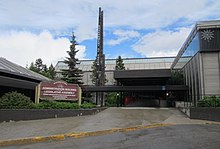
Yukon is the smallest and westernmost of Canada's three territories. It also is the least populated province or territory in Canada, with a population of 35,874 people as of the 2016 Census. Whitehorse, the territorial capital is the largest settlement in any of the three territories.

The provinces and territories of Canada are sub-national divisions within the geographical areas of Canada under the jurisdiction of the Canadian Constitution. In the 1867 Canadian Confederation, three provinces of British North America—New Brunswick, Nova Scotia, and the Province of Canada —were united to form a federated colony, becoming a sovereign nation in the next century. Over its history, Canada's international borders have changed several times, and the country has grown from the original four provinces to the current ten provinces and three territories. Together, the provinces and territories make up the world's second-largest country by total area.

Devolution is the statutory delegation of powers from the central government of a sovereign state to govern at a subnational level, such as a regional or local level. It is a form of administrative decentralization. Devolved territories have the power to make legislation relevant to the area and thus granting them a higher level of autonomy.
The Canadian order of precedence is a nominal and symbolic hierarchy of important positions within the governing institutions of Canada. It has no legal standing but is used to dictate ceremonial protocol.
Consensus government is a form of consensus democracy government in Canada used in two of Canada's three federal territories as well as in Nunatsiavut, an autonomous area in the province of Newfoundland and Labrador.
In Canada, a premier is the head of government of a province or territory. Though the word is merely a synonym for prime minister, it is employed for provincial prime ministers to differentiate them from the Prime Minister of Canada. There are currently ten provincial premiers and three territorial premiers. These persons are styled The Honourable only while in office, unless they are admitted to the Queen's Privy Council for Canada, in which case they retain the title even after leaving the premiership.

The Commissioner of Yukon is the representative of the Government of Canada in the Canadian federal territory of Yukon. The commissioner is appointed by the federal government and, in contrast to the Governor General of Canada or the Lieutenant Governors of the Canadian provinces, is not a viceroy and therefore not a direct representative of the Canadian monarch in the territory eo ipso.

The Legislative Assembly of the Northwest Territories, or Legislative Council of the Northwest Territories, is the legislature and the seat of government of Northwest Territories in Canada. It is a unicameral elected body that creates and amends law in the Northwest Territories. Permanently located in Yellowknife since 1993, the assembly was founded in 1870 and became active in 1872 with the first appointments from the Government of Canada.

The Yukon Legislative Assembly is the legislative assembly for Yukon, Canada. The Yukon Legislative Assembly is the only legislature in Canada's three federal territories which is organized along political party lines. In Nunavut and the Northwest Territories, the legislative assemblies are instead elected on a non-partisan consensus government model.

George Hedley Vicars Bulyea was a Canadian politician and the first Lieutenant Governor of Alberta. As the youngest ever Lieutenant Governor, at age 46, he was appointed by Governor General Earl Grey on advice of Prime Minister of Canada Sir Wilfrid Laurier on September 1, 1905.

The 1898 Northwest Territories general election took place on 4 November 1898. This was the fourth general election in the history of the Northwest Territories, Canada. It was held to elect members of the Legislative Assembly of the Northwest Territories.

The 1978 Yukon general election, held on November 20, 1978, was the first conventional legislative election in the history of Canada's Yukon Territory. Prior elections were held to elect representatives to the 24th Yukon Territorial Council, a non-partisan body that acted in an advisory role to the Commissioner of the Yukon. Following the passage of the Yukon Elections Act in 1977, the 1978 election was the first time that voters in the Yukon elected representatives to the Yukon Legislative Assembly in an election organized along political party lines.
Gender representation has been a significant issue in Canadian politics.
The Politics of Northwest Territories involves not only the governance of the Northwest Territories but also the social, economic and political issues specific to the territory. This includes matters relating to local governance and governance by the federal government of Canada, the inclusion of the aboriginal population in territorial affairs, and the matter of official languages for the territory.
This article provides a timeline of elections in Canada, including all the provincial, territorial and federal elections. The information starts from when each province was formed or entered the Confederation, and continues through to the present day.
The Yukon Territorial Council was a political body in the Canadian territory of Yukon, prior to the creation of the Yukon Legislative Assembly. Although not a full legislature, the council acted as an advisory body to the Commissioner of Yukon, and had the power to pass non-binding motions of legislation which would be forwarded to the commissioner for consideration.
In Canada, the federal government and most provinces and territories have passed legislation setting fixed election dates so that elections occur on a more regular cycle and the date of a forthcoming election is publicly known. However, the governor general, the provincial lieutenant governors, and the territorial commissioners do still have the constitutional power to call a general election on the advice of the relevant first minister at any point before the fixed date. By-elections, used to fill vacancies in a legislature, are also not affected by fixed election dates.
The following outline is provided as an overview of and topical guide to Yukon.









